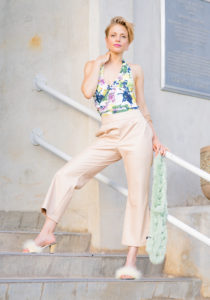When I was 20, I decided it was time to become a Good Person, and thought that minimalism could get me there. I donated half of my wardrobe, including anything colorful, and purchased a pair of tan trousers from a slow-fashion brand with money I should’ve spent on textbooks.
Minimalism seemed like the perfect moral framework—if I owned fewer things, surely that meant I was less materialistic and therefore more virtuous. Each beige, expensive, ‘eco-friendly’ purchase felt like a badge of honor. Unfortunately, my minimalist phase came to an abrupt end four months later, when Minnesotan winter hit and I cursed summertime minimalist-me who decided extra sweaters weren’t worth the closet clutter.
Minimalism became a popular trend for valid reasons: consuming less, simplifying life, and rejecting capitalist narratives. But if you’re anything like me, all the beige and gray gets boring (I see you Forever 31).
Today, a new movement has been sweeping social feeds with similar promises: the low-buy movement. If you, too, find yourself realizing that mindless consumption isn’t cutting it but you can’t imagine a life of aesthetic deprivation, then this piece is for you.
What is the Low-Buy Movement?
Unlike minimalism’s often aesthetic-focused approach, low-buy is about intentional consumption that challenges the foundation of our shopping habits.
At its core, low-buy recognizes something we are all waking up to: our economic system thrives by convincing us we’re perpetually lacking. The movement gained traction as many started realizing they were shopping not for clothes but for confidence, and not for skincare but for self-worth. It’s a quiet rebellion against the narrative that we’re forever one purchase away from being enough.
What the Low-Buy Movement is NOT
Let’s clear something up: low-buy is not about shivering through winter because you decided coats aren’t essential. You don’t have to deny yourself things you genuinely need.
It’s also not about forcing yourself into aesthetic choices that don’t bring you joy. If bold colors and patterns make your heart sing, a low-buy lifestyle doesn’t demand you replace them with beige and greige.
And perhaps most importantly, it’s not a competition. Nobody wins at the low-buy movement by suffering the most or having the emptiest shopping cart. It’s not about bragging on social media that you haven’t bought anything new since 2019. (Though if that’s you, honestly, what’s your secret?)
The Low-Buy Shift: How To Get Started
What if instead of feeling like you’re always lacking, constantly chasing trends, regretting an impulsive purchase, or never really fulfilled, you felt like you were already enough, able to authentically express yourself, and saw your items as meaningful parts of your life?
It may sound like a far-fetched mindfulness goal you need to meditate on for months…but it’s not. The mindset shifts and the practices go hand in hand. Pick what speaks to you from this list. There’s no one-size-fits-all approach to finding peace with what you own and buy.
From Always Lacking to Already Enough
The most radical act in today’s world might be believing you’re already enough, and don’t need to be “fixed” by yet another novelty facial cream. This shift is about resetting your baseline: instead of starting from feeling like not enough, start from a place of sufficiency.
Try: Taking Inventory.
- Spring cleaning is the perfect time to take stock of what you already own. Pull out everything from a category—whether it’s clothing, skincare, or accessories.
- Declutter what no longer serves you (mindfully), organize what remains, and commit to using what you have.
- Pull things out of drawers or ensure you can see them so you remember you have them.
- Note specific products or categories you won’t buy for a set period (for example, “no new purses for one year”).
From Following Trends to Authentic Self-Expression
When you’re constantly bringing in new clothes and styles, it’s nearly impossible to create a cohesive look to figure out what you actually like, versus what the algorithm has been pushing at you to buy. Taking a step back gives you space to curate a style that’s authentically you.
Try: A Personal Style Visioning Session:
- You can do this solo or work with a professional stylist like Kasi to do a deep dive on your style. That way, you’ll know what styles, cuts, and colors suit you best and how to rule out pieces that you may appreciate but just aren’t you.
- Start by observing people with similar body types and color as you and noticing what works and what doesn’t on them (it’s easier to do this for others than yourself). Pick people’s style you generally admire and write adjectives that describe it. Turn this all into a document with a few style personas written for yourself, along with colors and images (for example, one of Kasi’s personas is The Playful Intellectual).
- Use Pinterest to help you. Or book a Visioning Session with Kasi to make it easier.
From Impulsive Gratification to Intentional Selection
Our brains have been rewired for the dopamine hit of one-click ordering. A low-buy mindset reclaims your purchasing power from impulsivity and puts deliberate thought back into the equation.
- Try: The 24-Hour Rule: For non-urgent purchases, institute a waiting period. Add to cart, then close the tab. If you’re still thinking about it tomorrow, it might be worth reconsidering. For bigger purchases, extend to a week, or even a month. You might find, like me, that you totally forget about it.
- Try: “Use It Up” Challenge: Before buying any new beauty products, commit to using up what you already have. When I did this with makeup last year, I discovered I rarely used many products I’d bought. It also gave me time to research better replacements for when I truly ran out, which set me on a path towards cleaner beauty practices. If you’re ready for restock, consult this non-trend guide to effective, clean beauty.
From Temporary Satisfaction to Meaningful Investments
Rather than treating possessions as temporary and replaceable, this encourages developing deeper connections with fewer, better things.
Try: One-In-One-Out.
- For every new clothing or beauty item that enters your life, one must leave. This keeps your inventory steady and makes you question if that new purchase is worth losing something you already own.
- While this is a great practice to adopt, be mindful not to fall into a cycle of constantly purchasing and discarding. This doesn’t shift you into the low-buy mindset, and many donated clothes unfortunately go to waste. (Goodwill, for example, only resells about 30% of its donated merchandise. The rest is landfilled or shipped elsewhere.) The goal with the low-buy movement is thoughtful curation, not constant turnover.
From Individual-Focused to Community-Minded
Many shopping habits stem from isolation, and sharing what you have not only gives you more options without spending any money, but can also be a fun way to spend time with your people.
Try: Swap Parties.
- For clothes that you do get rid of, consider swapping or giving them to a friend, so they’re more likely to get re-worn.
- You can host clothing or beauty product swap parties with friends. Everyone brings items in good condition that they no longer wear, and you all get “new” items without actual shopping. This blog has some great tips.
- Plus, it’s a great way to get your friends on the low-buy bandwagon. You can do a permanent swap, or with friends you trust, do it for a month and then swap back.
- No buy groups are great places to promote these events if you want to extend them beyond your friend circle.
The Low-Buy Movement Across Different Areas of Life
While fashion and beauty might be where most of us feel the low-buy itch first, these principles extend beautifully to other areas. The core shift, from “I need more to be enough” to “I am enough and choose what adds value,” transforms everything it touches.
For home goods, it might mean asking if that trendy decor item will still bring joy in five years, or if you’re just responding to clever marketing. It could mean repainting furniture instead of replacing it, or accepting that your home doesn’t need to look “finished” to be lived in.
In the kitchen, it might mean evaluating if you really need that single-purpose avocado slicer, or if the knives you already own could do the job just fine. I bought a pack of Swedish reusable ‘paper towels’, and haven’t bought paper towels in over six months.
For technology, it’s questioning if each upgrade is necessary or if your current devices serve your needs perfectly well. Do you really need the newest phone when yours still works great?
Even entertainment can benefit from low-buy thinking—using libraries instead of building ever-growing bookshelves, or subscribing to just one streaming service at a time.
Maintaining a Low-Buy Lifestyle Long-Term
One secret to sustaining this mindset shift is community. Find your people who understand that you’re not just saving money—you’re reclaiming your self-worth from a system that profits from your insecurities. Start the conversation with your friends (by, say, sharing this article with them…)
As your relationship with consumption changes, you’ll notice ripple effects: more confidence in your authentic style rather than trend-chasing, more space (physical and mental) for what truly matters, and often, a surprising abundance. Not of things, but of contentment.
Adjust your approach as your life evolves. What works in your twenties might not in your thirties. Same for your thirties to your forties. The goal isn’t perfection; it’s awareness.
And when you inevitably “fall off the wagon”—as I did spectacularly during an apartment move, sure I needed to decorate the living room perfectly right now—be gentle with yourself. Even noticing the impulse is growth/. You’re seeing the de-programming at work.
A Middle Path Forward
The low-buy movement offers something minimalism often couldn’t: a sustainable, middle path between ascetic deprivation and mindless consumerism. It acknowledges that we live in a material world while questioning our relationship with material things.
Would I go back and tell my 20-year-old self to skip the beige trousers? Probably not. That uncomfortable experiment taught me something valuable – that simplifying my life didn’t have to mean simplifying my personality or denying myself things that bring genuine joy.
And that’s the true promise of low-buy: not a life with less, but a life with more of what actually matters—more authenticity, more intentionality, more alignment between your purchases and your values. In fighting back against the “never enough” message, you might discover you had enough all along.

Author Bio:
Jackie Warehime is a New York-based designer and sustainability advocate with a background in product design. She writes about sustainable design at www.jackiewarehime.com to explore and expand the ethical and sustainable approaches to crafting our world.




